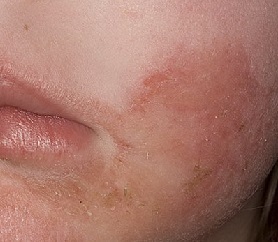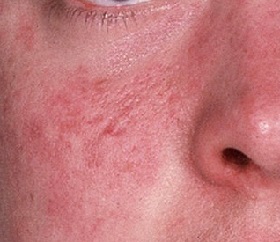 Dermatitis is a contact acute inflammatory lesion of skin tissue that occurs as a result of exposure to it of irritating factors of a chemical, physical or biological nature.
Dermatitis is a contact acute inflammatory lesion of skin tissue that occurs as a result of exposure to it of irritating factors of a chemical, physical or biological nature.
It belongs to the group of allergic dermatoses. Allergic dermatoses are known to be a heterogeneous group of skin diseases, the leading importance in the development of which is given to an allergic reaction of immediate or delayed type. This group includes: allergic, atopic, toxicermy, eczema, urticaria.
Dermatitis, the symptoms of which can develop under the biological, chemical or physical effects of various types of factors, respectively, can be manifested in a specific form, determined from the specifics of this impact, in this article we will consider what in general is the problem.
Classification
Depending on the cause of the onset and symptoms, there are:
- Seborrheic- a disease caused by a yeast-like fungus. However, this type of skin disease is not contagious. It has a chronic course, and is most often manifested on the skin of the face (forehead, nose, on the border of hair growth, eyebrows, ears).
- With contact dermatitis, substances that penetrate the skin are capable of causing inflammation due to an allergic or other reaction. It can occur when you get on the skin of various biological, mechanical or other irritants. The severity of manifestations of the disease depends on the time and strength of the stimulus.
- Allergic - a chronic disease that occurs gradually, within 1-2 weeks from the moment of interaction of the organism with the allergen, with repeated contact with it;
- Atopic- the most complex form of the disease, proceeds in a chronic form and develops in individuals who are predisposed to atopy (increased immunoglobulin E synthesis in the body);
To understand how to treat dermatitis it is necessary to determine its type, and then choose what to treat it.
Symptoms
Common signs of dermatitis, among which should be noted:
- The appearance on the skin of such elements as erythema, papules, rash, scaling in the form of scales and other;
- Sometimes there is swelling, tenderness in the area of inflammation;
- Often the process is accompanied by painful itching and burning;
- Sensitivity is disturbed in the affected areas until it is completely absent;
- Typical seasonality of the process, when the exacerbation is observed in the cold period, and remission - in the summer;
Symptoms of dermatitis
 Photo of dermatitis on face
Photo of dermatitis on faceIn the case of dermatitis, the symptoms in adults will directly depend on the severity and type of the disease.
- Seborrheic dermatitis is an inflammation of the skin of the scalp (however, there are other localizations disease), the main symptom of which is the presence on the surface of the skin fatty crusts of yellow color. The main cause of development is the fungus Malassezia furfur, which, multiplying on the surface of the skin, causes the appearance of symptoms of the disease.
- Symptoms of allergic dermatitis are characterized by the appearance of edema, erythema, vesicular eruptions, which are able to open and leave damp erosions. When the inflammatory process is attenuated, crusts and scales remain on the lesions. With slow allergic dermatitis, a skin change is possible, characterized by its thickening, coarsening and changing the skin pattern.
- Atopic dermatitis is considered a complex disease of an allergic nature. With this ailment, several factors directly affect the body. Predisposition to atopy (increased synthesis of immunoglobulin) is inherited, and as a rule, the disease develops at an early age. It is characterized by a strong reddening of the skin and marked swelling. Subsequently, bubbles are formed, which, when opened, leave a damp erosion. After the inflammation passes, on the skin there are crusts and scales.
Simple dermatitis occurs acutely or chronically. The acute form is characterized by a bright inflammation, accompanied by itching, burning, pain, and sometimes - the formation of blisters and areas of necrosis, leaving scars. Chronic form is manifested by congestion, cyanosis, thickening of the skin, lichenification (flaking), cracks, increased cornification, sometimes atrophy of the skin.
Factors provoking the development of ailment
Irritants, causing an obligatory inflammatory reaction in all people without exception, are called obligate. They are the cause of simple contact dermatitis.
Awaken allergic reaction can:
- synthetic substances;
- detergents, household chemicals;
- means of protecting plants from insects;
- cosmetic products containing dyes and preservatives;
- paint and glue, based on polymeric compounds;
- vegetable irritants.
Irritant agents that affect the cutaneous and mucous membranes of not everyone, but only some of the persons in contact with them, are called facultative, and lead to the development of allergic dermatitis, which is a consequence of increased sensitization of the body to allergens.
Dermatitis photo
Below is a photo of dermatitis on the hands and body. The manifestation will depend on the form of the ailment.
Treatment of dermatitis
When adults are diagnosed with dermatitis, treatment depends on its form, and is always selected individually.
First of all, the treatment of all dermatitis must begin with the elimination of an irritating factor. External therapy depends on the severity of the process and the nature of the elements of the rash. If the stimulus is not determined, as is often the case with allergic and especially neuro-allergic dermatitis, treatment will be only symptomatic, i.e. aimed at eliminating symptoms and maintaining the stage of remission.
Treatment of dermatitis is conservative, consists of local and general therapy. Acute dermatitis, as a rule, needs to be treated only with the use of local remedies, and chronic forms require a combination of general and local therapy.
Local treatment consists in the treatment of affected areas of the skin. Skin rashes are treated with anti-inflammatory and antibacterial drugs in the form of talkers, powders, ointments, solutions - depending on the form of the inflammatory element and its stage. Dermatitis on the face (seborrheic) is treated with antifungal ointments. Chronic forms are treated with the use of corticosteroid anti-inflammatory drugs, acute treated with aniline dyes. Deep ulcerative lesions are treated in a hospital.
The general treatment consists in taking immunomodulating, antihistamines, sedatives depending on the cause that caused the disease. It is also necessary to eliminate all sources of chronic infection, such as carious teeth destroyed by the caries, chronic sinusitis, tonsillitis, etc.

How to choose probiotics for the intestine: a list of drugs.

Effective and inexpensive cough syrups for children and adults.

Modern non-steroidal anti-inflammatory drugs.

Review of tablets from the increased pressure of the new generation.
 Antiviral drugs are inexpensive and effective.
Antiviral drugs are inexpensive and effective.



